|
HENRY HOBART - DROMORE
ARCHITECT
1858-1938
by ROSEMARY MCMILLAN
Forty years ago if you had mentioned the name "Hobart" to
me, I would in all probability have replied, "Capital of
Tasmania". It was the way we were taught in those days.
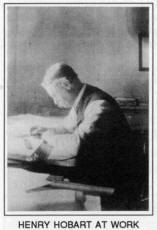 Recently,
the name has come to my attention again though in a
different context - architecture. On 24th October last, the
Dromore Historical Group was given a talk by Mr. Eugene
Corbett on "The Architecture of Henry Hobart and Samuel
Heron". It is from his thesis that I have gleaned much of
what follows. I also had the good fortune to meet and talk
with Henry Hobart's daughters, the Misses Maureen and Hannah
Hobart, who are responsible for some of the pertinent
comments quoted. Recently,
the name has come to my attention again though in a
different context - architecture. On 24th October last, the
Dromore Historical Group was given a talk by Mr. Eugene
Corbett on "The Architecture of Henry Hobart and Samuel
Heron". It is from his thesis that I have gleaned much of
what follows. I also had the good fortune to meet and talk
with Henry Hobart's daughters, the Misses Maureen and Hannah
Hobart, who are responsible for some of the pertinent
comments quoted.
Henry Hobart was born at Lagan Lodge on Christmas Eve
1858. As a boy he travelled daily by train from Dromore to
Belfast where he attended the Royal Belfast Academical
Institute. His partner of later years, Samuel Heron,
described to me as "another one stuffed full of brains",
also attended the same school, but it is not known if they
were acquainted at that time.
School days over, Henry Hobart was articled to William Lynn
for the sum of �1,000.
"a sum indicative of the high regard in which Lynn was held
among his peers".
In 1890 he returned home to Lagan Lodge, bringing with him
his bride, Miss Maria Lusk of Loughbrickland. Here he set up
his practice in a wonderfully light-filled room, which had
previously been used by his father in connection with his
linen business.
It was here that Hobart developed his talent for
designing buildings for all sorts of purposes. His work was
not only prolific, but displayed a great variety of styles.
He could, and did, design everything from a church to a cow
house. Banks, schools, warehouses and private houses, all
fell within the scope of his work: nor, as the records show,
did he turn away alterations and addition work. His style is
like an irregular verb, you have to learn it to appreciate
its complexities. It ranges from his own version of
free-style classical, reminiscent of the Dutch and English
red brick buildings of the 17th and 18th centuries, to a
plain, almost spartan, design. Miss Maureen Hobart thinks
Prince Charles "would like them better than the Tower
Block".
He went into partnership with Samuel Heron in 1904 and a
year later the firm moved to Belfast. The versatility of the
work from this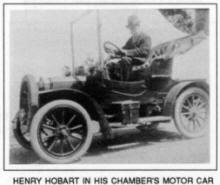 partnership can be seen across the six counties. Balrath
House - a private dwelling at Donaghmore, Co. Tyrone,
Gardenmore Presbyterian Church, Larne, Co. Antrim, a terrace
of 11 houses at Mill Street, Tandragee, Co. Armagh, Ulster
Bank, Irvinestown, Co. Fermanagh, Technical School,
Magherafelt, Co. Derry.
partnership can be seen across the six counties. Balrath
House - a private dwelling at Donaghmore, Co. Tyrone,
Gardenmore Presbyterian Church, Larne, Co. Antrim, a terrace
of 11 houses at Mill Street, Tandragee, Co. Armagh, Ulster
Bank, Irvinestown, Co. Fermanagh, Technical School,
Magherafelt, Co. Derry.
There was even a venture South to Trimblestown, Co.
Meath, where stables were designed for a Mr. F. Barber.
Hobart owned a magnificent Chambers motor which doubtless
proved invaluable in covering so wide a territory.
In the town of Dromore, Co. Down, although there is no
documented evidence of it, one of Hobart's first commissions
appears to have been alterations made to the Cathedral
Church of Christ the Redeemer in 1898 when
"a new chancel and Apse and a broad north aisle were added".
Another of his early commissions was for Messrs Murphy &
Stevenson Limited in 1896, when he designed a row of red
brick terrace houses - Holm Terrace, Lurgan Road. The same
firm commissioned him again in 1907 to design alterations
and additions to the Weaving Factory. The contractor was Mr.
J. Graham of Dromore and his tender for the work was �2,000.
In 1910 the Roman Catholic clergy commissioned him to
design a new Parochial House. This was built in the Church
grounds and the estimated cost for the work was �1,300.
In 1920 the Ulster Bank, appointed him as the architect
for their new branch. The two storey building was inserted
into a terrace in Church Street. The lower storey is of
rusticated sandstone and the upper of red brick.
Undated examples of Hobart designed buildings in Dromore
are, the Gate Lodge at the Cowan Heron Hospital, Neeson' s
Shop, Market Square and numbers 15,17 and 19 Lower Quilly
Road. There are known to be six unlocated houses in Dromore
designed by him - perhaps yours is one of them! Mr. Corbett
sums up his thesis as follows:
"Henry Hobart and Samuel Heron, for their time and place
in architectural history, produced works which, while not
being adventurous, were pleasing to the eye and which were
fine, sensible examples of popular styles and moods
prevailing at the time."
Miss Hannah Hobart puts it more concisely,
"Well, they aren't shoddy"

THE
PINNACLE MEADOW
by JIM HUTCHINSON
In my younger days the field by the river on the
Banbridge Road, and now opposite the High School, was known
as the pinnacle meadow bythe older inhabitants of Dromore.
At that time the field was often the venue for travelling
shows such as funfairs, circuses and the like.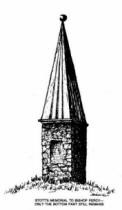
The reason for the name could only be the presence by the
river of a memorial to Bishop Percy, erected by his friend
Thomas Stott. But somehow to me, this squat, rectangular
edifice, hardly suggested a pinnacle, unless the local
people were easy to please pinnacle-wise!
Many years later my attention was drawn to an old
illustration in an equally old book, this showed the
memorial to originally have had a tapering pillar on the top
of what exists. One can only conclude that at some time this
pillar came off. But in it's original state it would have
been, to my mind, more like a pinnacle.
To-day the base of the memorial still stands in what has
now become the Town Park and the name still survives in "The
Pinnacle Youth Club" which exists in connection with the
High School across the road.
'THE MAN WITH THE WEE EYE'
(Contributed by John McGrehan)
The following poem written in the 1920's relates to the
work of weavers at Holm Factory. Murphy and Stevenson were
in business as damask weavers there at that time. The
writers name is not known, although this latter-day 'Rhyming
Weaver' was probably a worker in the factory. Other names
mentioned in the poem are certainly locally familiar.
It would appear that 'The man with the Wee Eye' was a cloth
passer -- a kind of quality controller who was responsible
for checking the finished work of the weavers. Not
unnaturally he had the reputation with the other workers of
being extremely strict in the discharge of his
responsibilities.
Now I have worked in many lands
And many sights I've seen
I've used a pick and shovel
In the little Isle of Green
But at present I am weaving
It's enough to make you cry
For the dread of all, both great and small,
Is the man with the wee eye.He stands behind
the counter
Just like an old bull pup
He sends the young lad Ireland
To bring Jack McDonald up
He looks at Jack so serious
And then to him he says,
"I'll have to fine you in a bob
Unless you mend you ways".
The next to go is McIlwrath
He says to him "My lad
You let the yarn stops out too long
It makes the cut look bad
You will have to be more careful
And keep to the straight path"
"It's a bad hook in the twilling bar"
Says Bobbie McIlwrath.
There is a weaver in the shop
His name is Sammy Mann
He weaves bad hooks right through the cut
And doesn't care a damn
Now just take me I darn't do this
It's enough to make you sigh
He has got a lot of favourites
Has the man with the wee eye.
There's Robbie and McGrehan
There's Turner and there's Burns
The cloth they take up week by week
Would give a man weak turns
But they've got the wind up
And I will tell you why
The man they fear from day to day
Is Mister McAvoy. |
He sent for Willie John one day
And says to him "Look sharp
Get out your shears and pick
Out all the dropped warp"
Now Willie John got angry
His teeth with rage he ground
But he either had to pick the cut
or loose a half a crown.There's McCracken and
McCandless
There is Bingham and there's Mann
There's Martin and McQuillan
They do the best they can.
Sometimes their best's not good enough
And then you will hear the cry
"You will have to make it perfect"
Says Mister McAvoy.
There's Acheson and Hamilton
They dread to hear the call
For when young Ireland comes for them
They very nearly fall.
"There's bad cards in this cut" he says
Then he looks at them so sly
He leads them both a terrible life
Does Mister McAvoy.
Now there's John Cardwell the oiler
He has got a rotten job
For when he puts on too much oil
it comes down with a blob.
And when Law Day comes around again
Poor John will give a sigh
"I've got to loop the loop again
With Mister McAvoy."
If I'm going to keep to weaving
I'll have to get a plate
And put it up my sleeve when I
Go up to meet my fate
But perhaps he will mend his manners
If not. look out my boy
There's murder on the skyline
For the man with the wee eye. |

|
Early postcard of
Holm Factory, Dromore |
 |
THOMAS STOTT-DROMORE'S FORGOTTEN POET
by ROY GAMBLE
They say a prophet has no honour in his own
country. In Ulster the same could be said of poets, or
rather, the memory of them, for despite a considerable
legacy of soulful outpourings passed on by local rhymers, it
seems we are poor custodians.
Dromore is no exception. How many citizens
know that the town once could boast of a resident poet? It's
a good few years ago of course (just over a couple of
centuries in fact), nevertheless, some of his writings are
still extant to-day.
Thomas Stott-the poet of Dromore, or as some
called him, the poet laureate of Downwas no Keats or
Wordsworth, nor did he claim to be. He said of his poems:
"They are the recreations of solitary hours snatched from
the hurry of business, furnishing innocent amusement and a
proof that literary recreation is not altogether
incompatible with the pursuits of commerce."
And yet he was a reasonably prolific writer,
contributing regularly to numerous journals and newspapers,
including the Belfast Newsletter and the London Morning
Post, where many of his poems appeared under the pen-name
'Hafiz' (Arabic for observer).
No ploughman poet, like Robert Burns and
John Clare, Stott was born suckling the proverbial silver
spoon, the son of a prosperous Hillsborough linen merchant.
He followed his father's calling and his first poems were
written when learning the linen trade in Waringstown.
He seems to have possessed a penchant for
non-de-plumes. Not only did he extensively employ the exotic
'Hafiz' he also used the colourful pseudonym 'Banks of Banna'
for some of his early poems, possibly in his Waringstown
days.
Stott eventually settled in Dromore, then a
thriving linen centre, and in 1777 he was married in the
town's cathedral to Mary Ann Gardiner, a lady of good
connections originally from Coleraine.
Goto Top
Stott and his new wife set up home in
'Dromore House' - which once upon a time served as the
'Clergy Widows Houses' - and rapidly built up a growing
business with several bleach greens in the meadows beside
the Lagan.
Many of his poems reflect his great love of
Dromore and its citizens. Poems like: "The Mount of Dromore"
in which he celebrates an annual Easter Monday custom of
youthful high jinks on the ancient Norman earthworks. Then
there is a satirical piece (shades of Orwell's 'Animal
Farm') where some educated pigs plead their case for a share
of the 'Liberty, Equality, Fraternity' that was sweeping
Europe at the time. In the "Humble petition of Dromore pigs"
he writes:
". . . We the swine of
Dromore
At a numerous meeting,
To all lovers of pork
This petition send greeting . . .
" And the poem ends:
"Dear liberty then
To us captives restore,
And our thanks shall resound
Through the streets of Dromore."
Incidently, it flows quite nicely to the
tune of Master McGra.

Throughout his life Stott retained a passion
for nature and wildlife. A keen fisherman and gardener, the
solitary hours spent on the river bank and among the shrubs
and flowers and fruitful trees of his garden must have given
him inspiration for such poems as: "the moralizing Trout",
"To May," "Sketch of a fine day in October," "To a
woodlark," and not to be outdone by his contemporary John
Keats- "To Autumn," which he describes as - "Crowned with
sickle and the yellow leaf."
Stott was no effete poet. He possessed a
fine business acumen and thought nothing of setting out from
Dromore on horseback to travel to the brown linen markets in
towns scattered throughout the province.
He wrote of such travels in a poem entitled
"The Brown Linen Buyers" in which he describes the homeward
journey: "Well lined with beefsteak and Irish champagne."
Dromore once had the honour of receiving a
letter from the great adventurer and romantic poet Lord
Byron. Apparently some of Stott's verse had attracted a
scathing attack from Byron during a certain literary
controversy of the time. On learning, some time later, that
Stott wrote merely for pleasure and not for profit, Byron
wrote to apologise for his earlier inconsidered remarks.
In later years Stott struck up a close
friendship with local patron of the arts, Bishop Percy of
Dromore. The memorial which stands in the pinnacle meadow
(which incidently was one of Stott's own bleach greens) was
raised by the poet in memory of the Bishop after his death
in 1811.
Stott died in Dromore house in 1829. He was
buried in the cathedral churchyard, within sight of his home
and not far from his beloved Lagan.
His grave, fourth in line to the right of
the main gate, is marked with this badly faded inscription:
"In the humble hope of
joyous resurrection.
Here rest deposited the earthly remains of
Thomas Stott esq.
Born Hillsborough on 21st June, 1755
He departed this life at his residence in
Dromore
The 22nd day of April, 1829.
In 1825, just four years before his death,
Stott's one and only book of poems "The Songs of Deardra"
was published.
This slim volume, a few poems in decaying
copies of ancient Belfast Newsletters, a worn tombstone, and
a painting hung in Castleward in which the poet and Bishop
Percy are prominent, is all that remains of the poet of
Dromore.
He never attained greatness and remained a
minor poet only. The evidence is that he never strove for
greatness. As he wrote in the title page of the "Songs of
Deardra":
"And if the world should not
prove kind,
As through its mazy paths ye stray,
Be not disheartened - fortune's blind,
And fame oft flatters to betray."
His poetry, even if it were readily
available, would not be much read today. The late 18th
century style is somewhat ponderous, the words pedantic.
Nevertheless, he was a man of his time and as a poet he
recorded what he observed and loved best - the simple
everyday scenes around Dromore and among the meadows beside
the Lagan.
In an age of instant electronic
entertainment it is no longer fashionable to read poetry.
This is a sad passing. A poet, especially a local one, is
also an historian, and the writings of Thomas Stott provide
us with a tangible link with the past.
Whether or not he saw himself as a keeper of
history we'll never know. There is little doubt though that
the urge to record the passing scene was strong. Perhaps, as
a modern poet puts it, "Of the fear of death - the need to
leave messages for those who come after saying, I was there,
I saw it too."
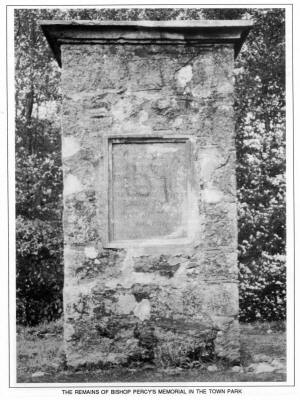

RECOLLECTIONS OF
CHILDHOOD ON A FARM IN CO. DOWN
by MURIEL McVEIGH Biddy was our trap horse.
It was she who was harnessed to our closed trap on every
occasion when travel away from the farm was necessary. She
was a bay with black mane and tail and might have had some
hunter blood in her, since when the Co. Down Staghounds or
the Iveagh Harriers came into the vicinity her ears pricked
up and she was ready to go. Twice a year at
the "screagh" of day Biddy was harnessed into the trap when
my father and the current "girl" set off for Newry Hiring
Fair. Their long day ended after we children had been packed
off to bed excitedly waiting for morning to meet either the
new "girl" or more than once to greet again the one we knew
who had come back to live with us as one of the family for
another six months. This help for my Mother was absolutely
necessary since the woman's role on the farm, as well as
rearing the family, was to milk ten cows twice a day, feed
the pigs - produce of four or five sows - and the calves
besides attending to poultry which entailed collecting eggs,
we children were useful here, setting broody hens to hatch
enough chicks to keep up the stock of Rhode Island Reds,
White Wyandots, Light Sussex, Black or White Leghorns so
that there would always be a good mix of layers and table
birds for the fowlman who called at the farm on a regular
basis. Then there were the big white Aylesbury ducks and
turkeys and geese for Christmas. All these activities had to
be fitted in with the cleaning, cooking daily for up to ten
people, skimming and setting cream to ripen for churning,
butter making and of course dress making and mending. Heigh
ho, farm life was busy.
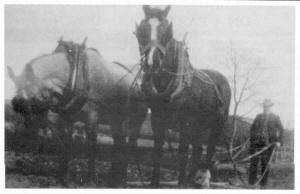 Biddy
was not solely a driving mare; she had to take her share of
the field work, though being rather skittish the work given
to her was of necessity selective. Acting as part of a team,
harrowing in the grain in spring or even reaping oats was
within her capacity, also I think she may have been chosen
to pull the turnip barrow when the seeds of this rootcrop
were sown in drills. Sharing the stable for many years were
Prince, the reliable bay gelding, strong and capable of
pulling a plough all day teamed up with Jewel, the big shire
mare with the broad back where three or four of us children
were able to ride home from the field after a long potato
digging day. There were some screams and holding on when
Jewel stepped down into the "shough" at the side of the lane
into the yard to have her long drink of fresh water. This
"shough" was there for the sole purpose of watering the
horses and was fed by a little river which came tumbling
down over the stones after flowing between the fields from
the flax dams where the flax was retted in the summer. No
doubt we children found other uses for both the river and
the "shough" though it was out of bounds for horses and
children when the dams were in use for flax. That was a busy
time when the pulled flax had to be carted to the dam and
the beets were neatly stacked in and we children were
allowed to walk all over them to push them down into the
water to be weighted down with heavy stones and big sods
when the water being dammed took over the softening of the
fibres for a week or ten days, after which the dirty work
started and the men with trouser legs rolled up threw the
soggy beets on to the "breugh" to be loaded back on to the
carts and taken to a grass field to be spread out to dry. At
that time the country stank of retted flax though I must
confess to enjoying the smell when the dry flax was
collected and tied into beets with rush bands then stacked
ready to be transported to the mill for scutching. The
lowering of the water in the dam was quite a problem for if
it entered into the larger rivers in bulk it was anything
but conducive to the life of the fish therein, though I
think I am right in saying a day's heavy rain helped to
disperse it. Biddy
was not solely a driving mare; she had to take her share of
the field work, though being rather skittish the work given
to her was of necessity selective. Acting as part of a team,
harrowing in the grain in spring or even reaping oats was
within her capacity, also I think she may have been chosen
to pull the turnip barrow when the seeds of this rootcrop
were sown in drills. Sharing the stable for many years were
Prince, the reliable bay gelding, strong and capable of
pulling a plough all day teamed up with Jewel, the big shire
mare with the broad back where three or four of us children
were able to ride home from the field after a long potato
digging day. There were some screams and holding on when
Jewel stepped down into the "shough" at the side of the lane
into the yard to have her long drink of fresh water. This
"shough" was there for the sole purpose of watering the
horses and was fed by a little river which came tumbling
down over the stones after flowing between the fields from
the flax dams where the flax was retted in the summer. No
doubt we children found other uses for both the river and
the "shough" though it was out of bounds for horses and
children when the dams were in use for flax. That was a busy
time when the pulled flax had to be carted to the dam and
the beets were neatly stacked in and we children were
allowed to walk all over them to push them down into the
water to be weighted down with heavy stones and big sods
when the water being dammed took over the softening of the
fibres for a week or ten days, after which the dirty work
started and the men with trouser legs rolled up threw the
soggy beets on to the "breugh" to be loaded back on to the
carts and taken to a grass field to be spread out to dry. At
that time the country stank of retted flax though I must
confess to enjoying the smell when the dry flax was
collected and tied into beets with rush bands then stacked
ready to be transported to the mill for scutching. The
lowering of the water in the dam was quite a problem for if
it entered into the larger rivers in bulk it was anything
but conducive to the life of the fish therein, though I
think I am right in saying a day's heavy rain helped to
disperse it. Outside school hours there was
always plenty to do and plenty to learn on the farm. The
sheep to be counted every day and in warm showery weather we
had to be specially vigilant to make sure that none of them
became fly-blown; the cows had to be brought in to be
milked; ducks and hens had to be shut in. Perhaps the most
enjoyable chore was helping to take the tea to the field at
harvest time for never did tea taste so good as it did in
the cornfield on a warm August day. In the spring corn had
to be carried to the sower whether he scattered the seed out
of a sheet skilfully draped round one shoulder or with an up
to date fiddle to speed up the process. On
rare occasions there was the reward of being loaded up into
the trap behind Biddy and going off to spend the day with
our grandparents who lived ten miles away. Then Biddy
stepped out smartly, trotting on the level and being helped
up the hills when those of us who could got out to stretch
our legs. We were shown many interesting things on the way
like the big water wheel which drove a mill somewhere near
Katesbidge or the farmhouse which had houseleek growing on
its roof or the bank where the dainty little blue harebells
grew and once we were delighted to be passing Magheral
Chapel when the bell was ringing the call to worship. Biddy never lost her fear of motors of any kind and when she
met one her instinct was to turn tail and run which but for
the quick reaction of my Father almost brought us to grief
more than once. Notably one thirteenth of July when we had
spent the day in Newcastle and were on our way home in a
downpour; suddenly round a corner came an charabanc, with
umbrellas along the sides and the passengers singing,
probably on their way home from Scarva. Well poor terrified
Biddy went up on her hind legs and turned right round on the
road and it was only the speed with which my Father reached
her head to soothe her that saved the lot of us.
I am afraid I have no recollection of what became of Biddy
for at the ripe old age of nine I learned to ride a bicycle
and from then on lost interest in horses. What happy days we
had growing up on the farm.

SOME DROMORE CLOCKMAKERS
by WILL PATTERSON In years gone by a number
of clockmakers plied their trade in Dromore. Research has
produced the following names of those who worked in the
town. Samuel Bailie had his business in
Dromore from 1765 to 1785. He made fine grandfather clocks
with brass dials. He numbered his clocks on the dials. Some
of his clocks are still around the Dromore area and
elsewhere. There were Bailies from Dromore who went to
Downpatrick and worked as clockmakers there. In fact there
are brass dial clocks marked 'Bailie of Down' which were
made by Bailie of Downpatrick. There was a
family called Cherry who were clockmakers in Dromore in the
eighteen hundreds. Clockmakers of the same name also worked
in Lurgan and Banbridge at this time. Indeed one was in
business as far afield as Philadelphia in 1849.
In the early 1800's a clockmaker named Crozier was active in
Newry and a James Crozier was in business in Dromore in
1854.
Scott (Christian name unknown) was at work in Dromore in the
late eighteenth/early nineteenth century.
David Sterling was a clockmaker in 1854.
Robert Sterling was in the town in 1865, but later moved to
Banbridge. George Arlow produced clocks in
the town from 1865 to 1868. They were white dialed with
mahogany cases. It is known that considerable number of
these still exist around the locality.
Another clockmaker family from the Dromore and Banbridge
area were the Nelsons. Some of their products still exist
around this area. J. & R. Nelson were in
Dromore from 1825 to 1835. Joseph and Robert
from 1846 to 1859. Robert Nelson (1) from
1825 to 1846. Some of the Nelsons went to New
York, where they founded a very successful clock and watch
business. It would be of interest to learn if
anyone in the vicinity have in their possession any examples
of the aforementioned craftsmen's work.
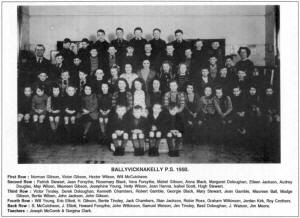
 |